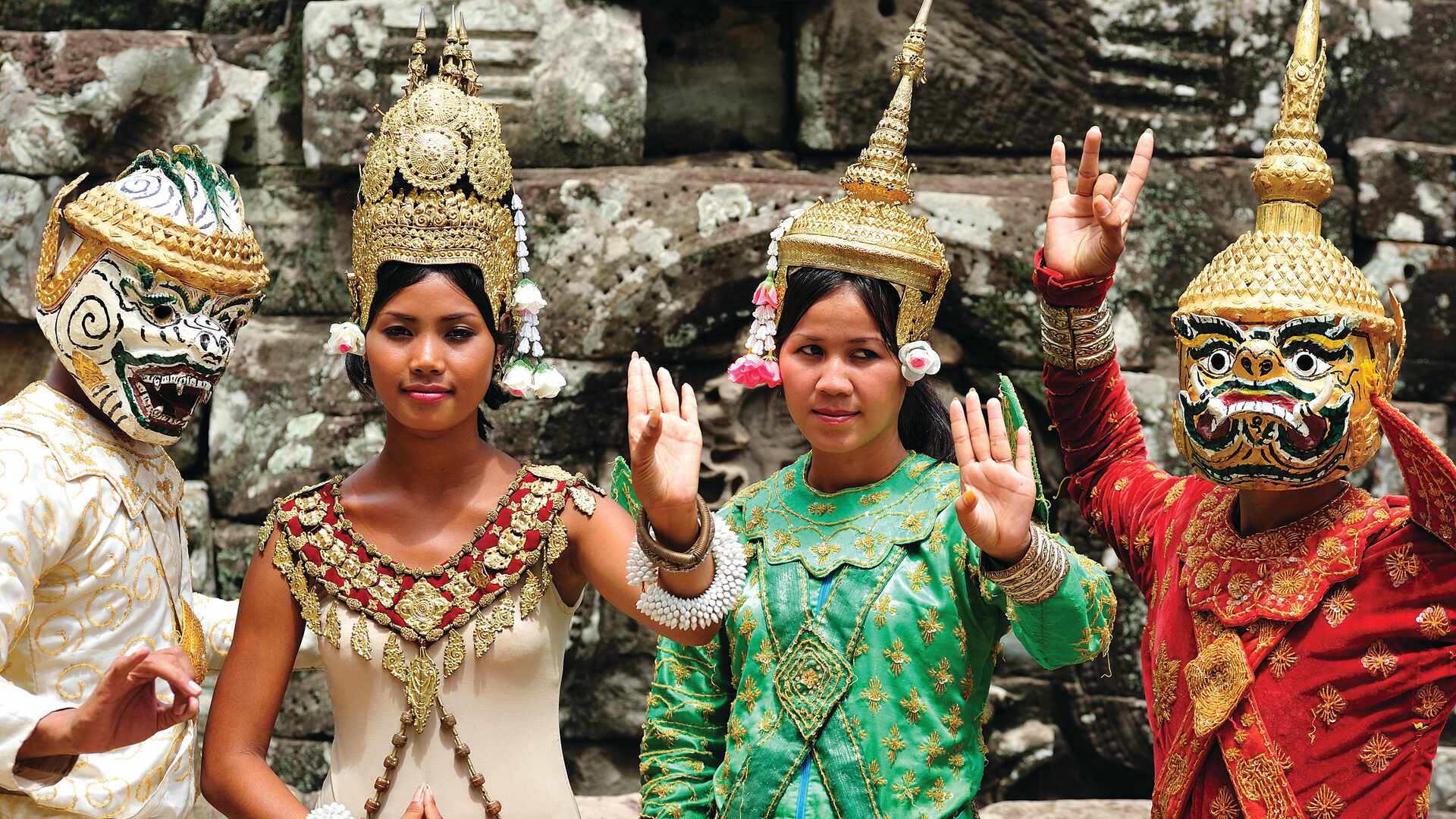Cambodia's Khmer Culture
Cambodia’s famed apsara dance is an essential part of Khmer culture, steeped in history and mythology. Katrina Lobley explores its fascinating origins.
Cambodia’s Royal Ballet, also known as Khmer classical dance or apsara dancing, is famous for its intricate costumes and graceful hand gestures. The hand gestures, where fingers and wrists are flexed and flared at extreme angles, are achieved only after years of intensive training that starts from a young age. The “Dance of the Apsara Divinities” incorporates more than 1,500 hand gestures. To put that in perspective, if you were to learn just one gesture a day, it would take more than four years to conquer the entire repertoire.
Apsara, in case you’re wondering about the word itself, is a concept that stems from both Hindu and Buddhist mythologies. Apsaras were celestial beings –supernatural ethereal nymphs –who descended from heaven to entertain both gods and kings with their dance. Akin to angels, these female spirits who inhabited the skies were seen as messengers of peace between the mortal and celestial worlds. Their power was considered limitless, as neither divinities nor mere mortals could resist their charms.
Today, the art form is the work of earth-bound angels (although you can also try it for yourself at Cambodian dance schools that offer introductory lessons). Apsara dancing has been entwined with the Khmer royal court for more than 1,000 years. Traditionally, apsara dance performances accompanied royal ceremonies and other key events such as coronations, marriages, funerals and holidays. It’s said that the most famous Khmer king of the Angkorian period, Jayavarman VII, who ruled in the 12th century, had more than 3,000 apsara dancers in his royal court.
These traditional dancers are immortalised in the intricate bas-reliefs that decorate Angkor temples built in Cambodia between the 8th and 13th centuries. Sculpted Khmer female figures who are dancing or appear poised to dance are considered apsaras while other female figures –depicted facing forward in the manner of temple guardians or custodians –are called devatas (deities).
The most famous of Cambodia’s temples –the 12th-century Angkor Wat, centrepiece of the World Heritage-listed Angkor Archaeological Park that sprawls over 400 square kilometres near Siem Reap –is a great place to spot the apsaras used as decorative motifs on pillars and walls. Each one of them is unique, and historians have documented their 37 different hairstyles.
Since 1997, the German Apsara Conservation Project has collaborated with a team of Khmer conservators to restore these precious sandstone reliefs from the devastating effects of centuries of erosion, while also working to protect them from further weathering. It is impossible to visit Cambodia without learning about the horrors of the Khmer Rouge regime, especially if you visit sobering sites such as the Killing Fields Museum outside Phnom Penh and the Tuol Sleng Genocide Museum within the capital. Under despot Pol Pot’s murderous rule, millions of Cambodians were killed between 1975 and 1979. This reign of terror almost wiped out the art of apsara dancing as well.
As UNESCO wrote, after inscribing the cherished art form on its list of the Intangible Cultural Heritage of Humanity in 2008: “The Royal Ballet practically ceased to exist under the repressive rule of the Khmer Rouge, who eliminated almost all master dancers and musicians. Immediately after Pol Pot’s defeat in 1979, dance troupes re-emerged and performances of the ancient repertory resumed. “The ballet has regained much of its former splendour but still faces numerous difficulties, such as a lack of funding and suitable performance spaces, competition from modern media and the risk of becoming a mere tourist attraction.”
It is hoped that future generations continue to learn this sacred dance, which is much loved throughout Cambodia as an emblem of Khmer culture. For apsara dancing not only embodies traditional values such as refinement, respect and spirituality, its repertoire also keeps alive the legends that tell the origins of the Khmer people.
The next time you have an opportunity to watch an apsara performance, see if you can identify the four character types that exist in the classical repertory. Thanks to the use of distinctive colours, costumes, make-up and masks, you should be able to spot Neang the woman, Neay Rong the man, Yeak the giant and Sva the monkey. Drawing upon that wide gamut of gestures and poses, the dancers evoke a soap-opera-worthy range of emotions that might run from fear, anger and rage through to love, joy and delight. The dance is usually accompanied by an orchestra and a female chorus that highlights the emotions projected by the dancers while also providing a running commentary on the storyline.
Need To Know
You’ll experience several performances of the apsara dance on APT’s 17 Day Vietnam and Cambodia Discovery tour. Here are other highlights of the itinerary.
Cruise
This tour includes a seven-night cruise along the Mekong River on board APT’s Mekong Serenity. It’s the best way to experience life on one of the world’s most colourful rivers: unpack once, then cruise in luxury, taking in all the sights and sounds from your floating hotel. The menu on board offers traditional local food as well as Western fare.
Do
Your three-day cruise on World Heritage-listed Ha Long Bay includes a raft of interesting experiences, taking part in a traditional Vietnamese tea ceremony, exploring the Cua Van Floating Culture Centre and discovering Cat Ba National Park. Further south, in Ho Chi Minh City, choose from two fascinating outings: attend a memorial service that marks the Battle of Long Tan or explore the incredible Cu Chi tunnel network. In Cambodia, you’ll enjoy an unforgettable sight: witnessing the sun rise over Angkor Wat.




